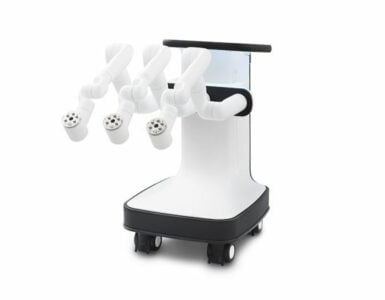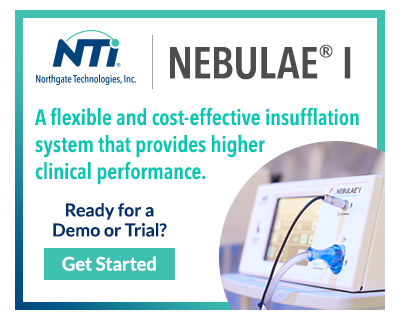Auris Health, Inc., a subsidiary of Ethicon, Inc.,*a Johnson & Johnson MedTech company,** today announced that its MONARCH® Platform received 510(k) clearance from the U.S. Food and Drug Administration (FDA) for endourological procedures. This clearance makes MONARCH the first and only multispecialty, flexible robotic solution for use in both bronchoscopy and urology. It is designed to enable urologists to reach and visualize areas within the kidney with precision and control.
About one in 11 Americans will experience a kidney stone in their lifetime,1 and many who do will experience pain severe enough to seek emergency room care.2 In patients who require treatment through surgery, one in two will require retreatment within five years.3
“With this FDA clearance, MONARCH is poised to aid physicians in their goals of reducing overall retreatment and complication rates,” said Jaime Landman, MD***, Chairman & Professor, Department of Urology at University of California Irvine. “Furthermore, as physicians strive to elevate the standard of care and improve outcomes, MONARCH supports them in their primary goal of rendering patients stone free in a single procedure.”
MONARCH provides urologists with one platform that supports both ureteroscopic and percutaneous nephrolithotomy (PCNL) procedures. Ureteroscopic procedures are the most common surgical stone procedures globally but become increasingly challenging as stone size increases.4 PCNL procedures have demonstrated superior stone clearance for patients with larger kidney stones, yet they represent only 7-8% of stone procedures conducted in the U.S. today.5
Numerous barriers hinder more frequent use of PCNL. MONARCH overcomes many of these obstacles by using unique and minimally invasive technology.
“MONARCH reduces the complexity of gaining high-quality percutaneous access and aids stone clearance efficiency through simultaneous fragmentation and suctioning of stones with robotic assistance,” said Mihir Desai, MD,*** Professor of Clinical Urology, University of Southern California. “With this platform, many urologists may be willing to expand their practice to include percutaneous access and PCNL procedures, thereby increasing patient access to more effective treatments closer to home.”
Since 2018, physicians have used MONARCH to perform robotically assisted bronchoscopy procedures and reach small, hard-to-reach peripheral lung nodules at an earlier stage and with greater precision than ever before.
“This latest FDA 510(k) clearance for MONARCH delivers on our vision to extend the robotic platform’s capabilities across multiple specialties, enabling hospital systems to target two disease states using one device,” said Vladimir Makatsaria, Company Group Chairman, Ethicon. “At Ethicon, we’re committed to driving meaningful innovation that elevates the standard of care for patients and delivers improved solutions that address important clinical challenges for our customers.”
Following this approval, Ethicon expects to initiate a first-in-human clinical study later this year for the MONARCH Platform’s endourologic application.
*Ethicon represents the products and services of Ethicon, Inc., Ethicon Endo-Surgery, LLC, Auris Health, Inc., and certain of their affiliates. All other trademarks are the property of their respective owners.
**Comprising the surgery, orthopaedics, vision and interventional solutions businesses within Johnson & Johnson’s MedTech segment.
***Dr. Landman and Dr. Desai, are paid advisors for Auris Health, Inc.
REFERENCES:
- Charles D. Scales, Jr., Alexandria C. Smith, Janet M. Hanley, Christopher S. Saigal, and Urologic Diseases in America Project. “Prevalence of Kidney Stones in the United States.” ncbi.nlm.nih.gov. European Urology. European Association of Urology. 2012 July; 62(1): 160–165.
- Gregory Foster, MPH, MA, Carol Stocks, MHSA, RN, and Michael S Borofsky, MD. “Emergency Department Visits and Hospital Admissions for Kidney Stone Disease, 2009, Statistical Brief #139.” ncbi.nlm.nih.gov. Healthcare Cost and Utilization Project (HCUP) Statistical Briefs. 2012 July.
- Saeed R. Khan, Margaret S. Pearle, William G. Robertson, Giovanni Gambaro, Benjamin K. Canales, Steeve Doizi, Olivier Taxer, Hans-Göran Tiselius. “Kidney Stones.” pubmed.ncbi.nlm.nih.gov. Nature Reviews Disease Primers. Nature Publishing Group. 2016 Feb 25;2:16008. doi: 10.1038/nrdp.2016.8.
- Charles D. Scales, Jr., Alexandria C. Smith, Janet M. Hanley, Christopher S. Saigal, and Urologic Diseases in America Project. “Prevalence of Kidney Stones in the United States.” ncbi.nlm.nih.gov. European Urology. European Association of Urology. 2012 July; 62(1): 160–165.
- Chung KJ, Kim JH, Min GE, Park HK, Li S, Del Giudice F, Han DH, Chung BI. Changing Trends in the Treatment of Nephrolithiasis in the Real World. J Endourol. 2019 Mar;33(3):248-253. doi: 10.1089/end.2018.0667. Epub 2019 Feb 13. PMID: 30628473.
Source: Ethicon.











